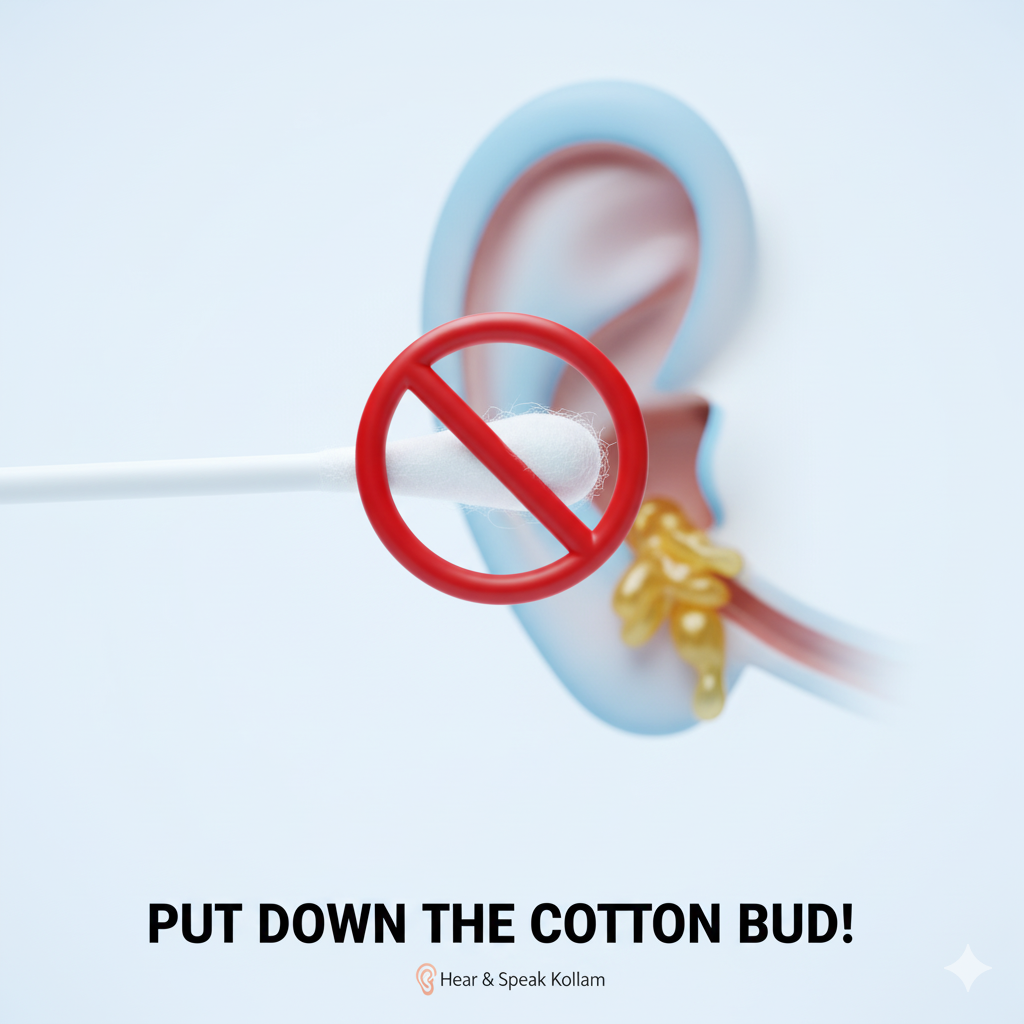A Guide to Ear Cleaning: What’s Safe and What’s Not (Hint: Put Down the Cotton Bud!) 👂
It’s a habit for many of us. After a shower, we reach for a cotton bud (or Q-tip) and start “cleaning” our ears. It feels productive, like we’re getting rid of dirt. But what if we told you that this daily ritual is not only unnecessary but also potentially dangerous?
As hearing health specialists in Kollam, we see the consequences of improper ear cleaning all the time. It’s one of the most common myths we have to bust. So, let’s set the record straight on earwax and how to manage it safely.
First, Understand Earwax (Cerumen): It’s Not the Enemy
Before you try to remove it, it’s important to know that earwax (the medical term is cerumen) is not dirt. It’s a natural, healthy substance produced by your ear canals with several important jobs:
- It Cleans: Earwax traps dust, debris, and dead skin cells, preventing them from going deeper into your ear.
- It Protects: It has antibacterial and antifungal properties, helping to prevent ear infections.
- It Moisturises: It keeps the skin inside your ear canal from getting dry and itchy.
Your ears have a remarkable self-cleaning mechanism. The natural movement of your jaw from talking and chewing, combined with skin migration from inside the ear canal, slowly pushes old earwax out.
The Dangers: What’s NOT Safe for Your Ears
The number one rule of ear cleaning is simple: do not put anything smaller than your elbow in your ear! This specifically includes:
- Cotton Buds / Q-tips: Instead of removing wax, they act like a ramrod, pushing the wax deeper into the ear canal. This can cause a blockage (impaction) against the eardrum.
- Hairpins or Keys: These sharp objects can easily scratch the delicate skin of the ear canal, leading to painful infections.
- Ear Candles: There is no scientific evidence that ear candling works. In fact, it’s incredibly dangerous and can cause serious burns, blockages from candle wax, and even perforation of the eardrum.
Using these objects can lead to earwax impaction, infections, tinnitus (ringing in the ears), and even a punctured eardrum.
The Safe Approach: How to Actually Clean Your Ears
So, what should you do? For most people, the answer is very little.
- Let Your Ears Do Their Job: Trust the natural self-cleaning process.
- Clean the Outside Only: When you bathe, simply use a washcloth to gently wipe the outer part of your ear. That’s it.
- Soften Stubborn Wax (With Caution): If you feel a slight build-up, you can use a few drops of medical-grade olive oil or an over-the-counter earwax softening solution for a few days to soften the wax, allowing it to come out on its own. However, do not do this if you have an eardrum perforation or an active infection.
When to See a Professional in Kollam
At-home methods are not always enough. You should stop trying to manage earwax yourself and see a professional audiologist or ENT if you experience any of the following symptoms:
- A feeling of fullness or a “plugged” sensation in your ear
- Earache or pain
- Muffled hearing or sudden hearing loss
- Ringing in the ear (tinnitus)
- Dizziness or balance issues
At our Kollam clinic, we can safely and effectively remove impacted earwax using professional methods like gentle suction (microsuction) or specialized instruments. It’s a quick, painless, and—most importantly—safe procedure.
Your Hearing is Precious. Don’t Risk It.
Stop the risky habit of using cotton buds. Your ears are designed to take care of themselves. If you are experiencing discomfort or blockage, don’t guess—get an expert opinion.
If you’re concerned about earwax buildup, contact Hear & Speak in Kollam today. We can assess your ears and provide a safe, professional cleaning to keep you hearing clearly.

